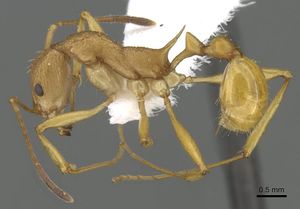Key to Malagidris species
This worker key is based on: Bolton, B. & Fisher, B.L. 2014. The Madagascan endemic myrmicine ants related to Eutetramorium (Hymenoptera: Formicidae): taxonomy of the genera Eutetramorium Emery, Malagidris nom. n., Myrmisaraka gen. n., Royidris gen. n., and Vitsika gen. n. Zootaxa 3791:1–99. doi:10.11646/zootaxa.3791.1.1
You may also be interested in
1
- Head relatively broad (CI 81–84). Scape relatively short (SI 97–108); when scape laid straight back on head, in full-face view, its apex reaches, or fractionally exceeds, the posterior margin. Metafemur relatively short, MfL/HW 1.25–1.35. Subpetiolar process subtended by a narrow cuticular crest that extends posteriorly beyond the level of the spiracle . . . . . Malagidris belti
- Head relatively narrow (CI 56–74). Scape relatively long to extremely long (SI 145–231); when scape laid straight back on head, in full-face view, its apex very conspicuously surpasses the posterior margin. Metafemur relatively long, MfL/HW 1.70–3.13. Subpetiolar process not subtended by a cuticular crest . . . . . 2
2
return to couplet #1
- More densely setose species: in full-face view 4–5 setae project from side of head behind eye, and in addition 1–2 project out from below the eye; a pair of setae present in the metanotal groove, and at least 1 pair of setae on propodeal dorsum. Metafemur relatively shorter, MfL/HW 1.70–1.83, in anterior or posterior view relatively more stout, MfL/MfH 4.60–5.50 . . . . . Malagidris dulcis
- Less densely setose species: in full-face view 0–3 setae project from side of head behind eye, setae never project out from below the eye; without setae in the metanotal groove, and propodeal dorsum without setae. Metafemur relatively longer, MfL/HW 1.95–3.20, in anterior or posterior view relatively slender, MfL/MfH 5.77–12.29 . . . . . 3
3
return to couplet #2
- Scape extremely elongated, SI 201–231; head relatively narrow, CI 56–62; metafemur relatively very long and slender, MfL/HW 2.81–3.20, MfL/MfH 10.24–12.29. Pronotal dorsum predominantly very densely reticulate-punctulate, also with minute, low, weak disorganised rugulae, but the rugulose sculpture is secondary to the reticulate-punctulate component . . . . . Malagidris sofina
- Scape shorter, SI 160–192; head relatively broader, CI 65–73; metafemur relatively shorter and deeper, MfL/HW 1.95–2.65, MfL/MfH 5.77–8.92. Pronotal dorsum predominantly reticulate-rugose; spaces between the rugae smooth, or with punctulate ground sculpture, any punctulae present are usually distinctly secondary to the rugose component . . . . . 4
4
return to couplet #3
- Propodeal spines very broad basally, extremely elevated, and so strongly recurved that their apices are directed anterodorsally. Smaller species, HW 0.72–0.78, SL 1.20–1.30, MfL 1.42–1.54 . . . . . Malagidris galokoa
- Propodeal spines straight to feebly sinuate, never recurved so that their apices point anterodorsally. Larger species, HW 0.82–1.12, SL 1.45–1.98, MfL 1.86–2.76 . . . . . 5
5
return to couplet #4
- Median clypeal seta arises from a prominent, raised, false anterior margin, below which is a vertical or reflexed section of the clypeus that descends to the true anterior margin; outline of clypeus in profile is roughly an anteriorly-directed V-shape. Pronotal dorsum usually with 1–2 pairs of setae present. Side of head in front of eye with a single projecting seta (rarely absent), side behind eye with 1–3 projecting setae. With head in profile the dorsum above the eye flat or very nearly flat, without a distinct concave impression or indentation . . . . . Malagidris jugum
- Median clypeal seta does not arise from a raised false anterior margin; outline of clypeus in profile is more or less evenly convex. Pronotal dorsum usually without setae. Side of head, both in front of and behind the eye, without projecting setae. With head in profile the dorsum above the eye distinctly indented and concave, the outline of the impression rising posteriorly to the highest point of the vertex . . . . . Malagidris alperti











